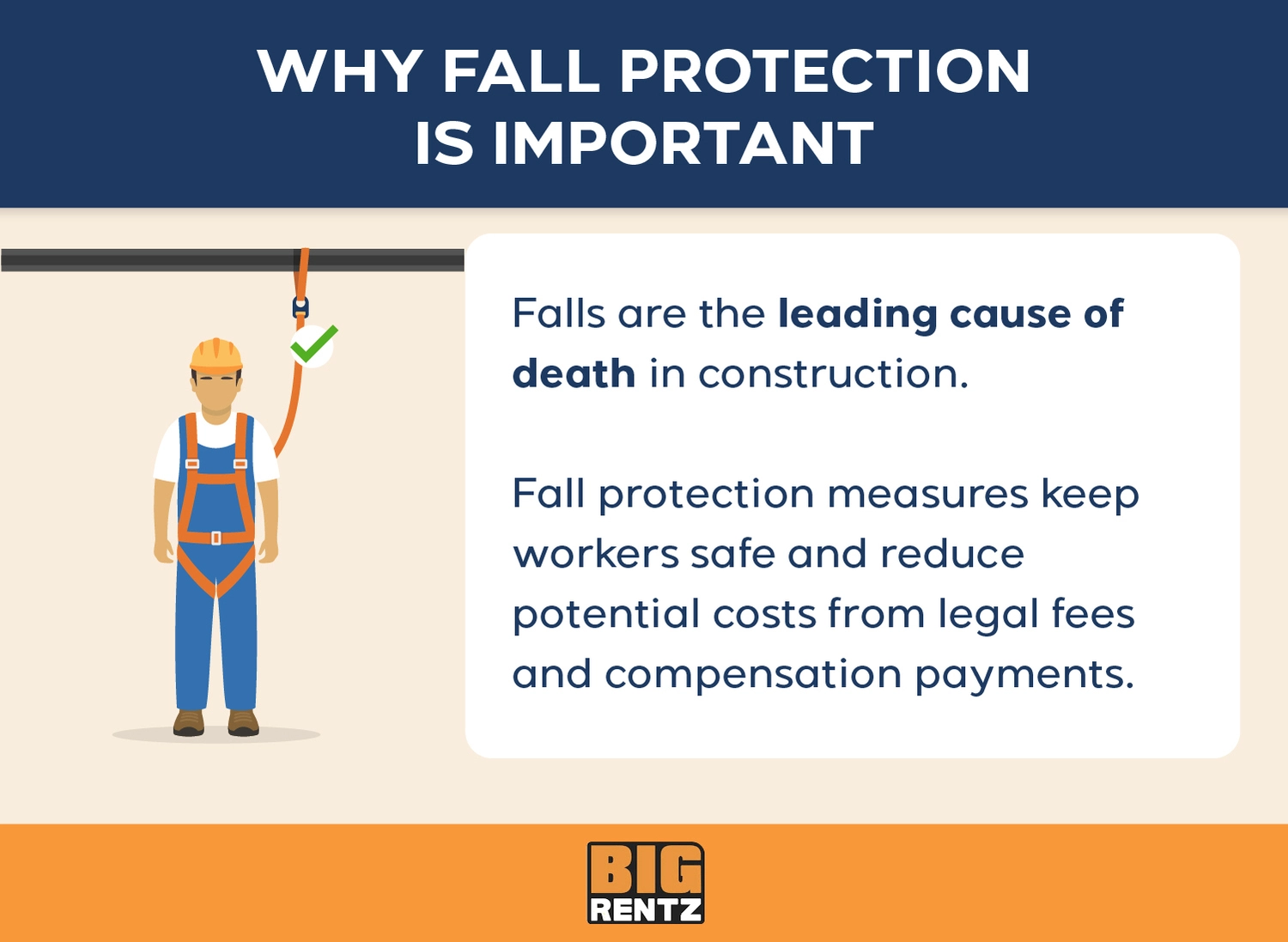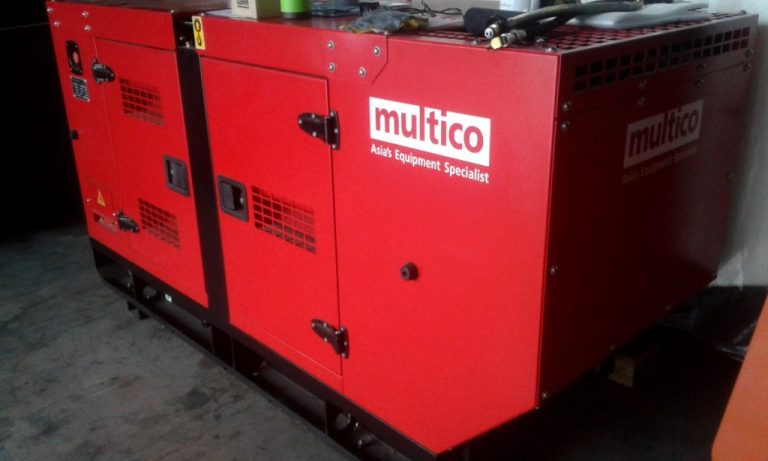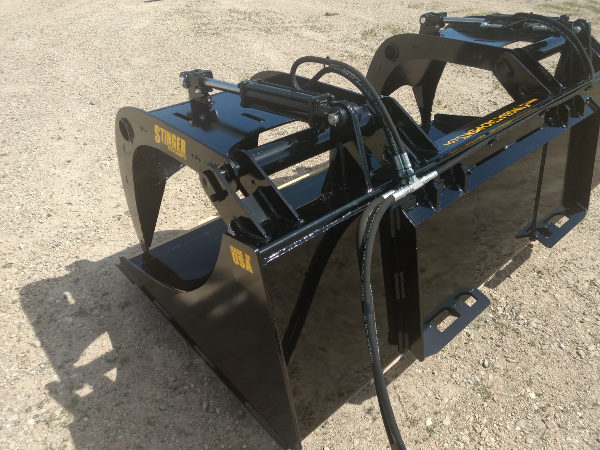What Height Is Fall Protection Required? Essential OSHA Regulations
Given that falls are a common cause of workplace injuries and deaths, the United States Department of Labor Occupational Safety and Health Administration (OSHA) has detailed fall protection requirements to protect workers.
These requirements are complex and depend on the industry and specific workplace situation. Here are the heights fall protection is commonly required:
- General industry workplaces: four feet (1910.28(b)(1)(i))
- Construction: six feet (1926.501(b)(1))
- Dangerous equipment: When working over dangerous equipment, such as above machinery with moving parts, fall protection is required at any height (1910.28(b)(6))
In this post, we explain OSHA’s fall protection requirements in simple terms as they apply to common situations in construction, so you can work safely without breaking any regulations.
Table of Contents
- Common Fall Protection Heights Explained
- Why Is Fall Protection Important in Construction?
- How to Meet OSHA’s Fall Protection Requirements
- Consequences of Not Adhering to OSHA Fall Protection Requirements
- Rent Safe and Well-Maintained Equipment from BigRentz
Common Fall Protection Heights Explained
Here’s an overview of common fall protection heights, according to OSHA standards.
| Situation/Industry | OSHA Standard | Height Fall Protection is Required |
| General workplaces | 1910.28(b)(1)(i) | 4 ft (1.2 m) or more |
| Construction | 1926.501(b)(1) | 6 ft (1.8 m) or more |
| Scaffolding | 1926.451(g)(1) | 10 ft (3.1 m) or more above a lower level |
| Steel erection | 1926.760(a)(1) | 15 ft (4.6 m) or more (for connectors, it’s 30 ft/9.1 m or more than two stories, whichever is less) |
| Ladders and stairways | 1926.1053(a)(18) and 1926.1052(c)(12) | For ladders, if the total length of a climb equals or exceeds 24 feet or the climb is less than 24 feet but the top of the ladder is higher than 24 feet above lower levels
For stairways, required at all heights if there are unprotected sides and edges |
| Working over dangerous equipment | 1910.28(b)(6) | All heights |
Fall protection can be in the form of:
- Guardrail systems: Guardrails should be placed around edges or openings where workers could fall.
- Safety net systems: Mesh nets placed under the working surface need to be able to absorb the force of a 400-pound bag of sand (28 to 32 inches in diameter) dropping onto it from the highest point.
- Personal fall protection systems (such as personal fall arrest systems, travel restraint, or positioning systems): These typically include a full-body harness, a lanyard and lifeline, and an anchorage point.
Although construction sites may seem like an obvious place for fall restraint systems, fall prevention is necessary in more than just the construction industry. These next sections explain fall protection standards you need to follow.
1. General Workplaces
According to OSHA standard 1910.28(b)(1)(i), in general workplaces, employers must ensure that any employee working on a surface with an unprotected side or edge that is four feet (1.2 m) or more above a lower level is protected from falling.
If the use of fall protection systems isn’t possible or creates an even greater hazard, employers must develop and implement a fall protection plan that meets standard 1926.502(k) and training that meets 1926.503(a) and (c). This standard is meant to show that even a short fall distance can still result in serious injuries in a general workplace setting.
2. Construction
According to OSHA standard 1926.501, employees performing construction tasks on a surface with an unprotected side or edge six feet (1.8 m) or more above a lower level need fall protection equipment.
This standard covers a wide range of construction scenarios:
- Common ones, like working on roofs or near unprotected edges
- Less common ones, like working near holes, overhand bricklaying, and working on ramps and walkways where the need for fall protection is less obvious
3. Scaffolding
According to OSHA standard 1926.451(g), employees using scaffolding more than 10 feet above a lower level must be protected from falling. This doesn’t apply to all work platforms though. Because scissors lifts are considered mobile scaffolding this standard applies, but it does not apply to aerial lifts.
The types of fall protection required vary based on the type of scaffold and the task being performed. Having workers complete OSHA training and preparation before beginning a job to make sure they’re safe.
4. Steel Erection
According to OSHA standard 1926.760(a)(1), employees conducting steel erection tasks on a walking-working surface with an unprotected side or edge more than 15 feet above a lower level must be protected from falling. However, for employees connecting steel members, this only applies at 30 feet or two stories, whichever is less.
According to 1926.760(b)(3), if you’re working at a height between 15 and 30 feet you need to wear fall protection equipment that attaches to a secure anchor point.
5. Stairways and Ladders
The rules for stairways and ladders vary, so it’s important to consult OSHA requirements directly and undergo training for your exact situation. Standard 1926.1053(a)(18) states that ladders where the length of the climb is less than 24 feet but the top of the ladder is higher than 24 feet above lower levels need to be equipped with fall protection safety features. These are also needed where the total length of a climb equals or exceeds 24 feet.
Safety features can be cages, wells, safety devices for ladders, or lifelines that can retract on their own. Standard 1926.1052(c)(12) states that unprotected sides and edges of stairway landings need to have guardrail systems at all heights.
6. Over Dangerous Equipment
Standard 1910.28(b)(6)(i) states that employees working over dangerous equipment need fall protection at all heights. Examples of dangerous equipment might include machinery with moving parts, hot surfaces with a risk of burns, electrical equipment with risk of electric shock, and heavy equipment.
Why Is Fall Protection Important in Construction?
Falls are the leading cause of death in the construction industry. That’s why complying with OSHA regulations on fall protection is crucial to keeping you and your employees safe.
Employees also have a legal right to a safe workplace. Following these standards helps promote a culture of workplace safety.

Also, workplace injuries and fatalities can result in significant costs, including medical expenses, workers’ compensation payments, and potential legal fees.
How to Meet OSHA’s Fall Protection Requirements
Meeting OSHA’s standards may seem challenging, but they’re comprehensive to keep workers and workplaces safe. Here’s a step-by-step guide to complying with OSHA’s fall protection requirements.

1. Assess Risk
Considering what fall hazards exist on your jobsite before work begins is the first step to meeting OSHA’s requirements.
Conduct a hazard assessment of your site to identify any potential fall hazards, including unprotected edges, floor holes, roof openings, skylights, and leading edges, and which workers on your team may be affected. Your risk assessment should also anticipate future hazards that could come up as work progresses.
OSHA standards state that the person conducting the assessment must be a competent person qualified to assess fall hazards.
2. Create a Fall Protection Plan
The next step is to develop a fall protection plan that details how to address the risks you identified. This plan should cover:
- Details about the job site and the work required
- A list of fall hazards and equipment used
- Which fall protection systems and safety will be used
- Rescue plans if a fall occurs
- How workers will be trained
3. Implement Fall Protection Measures
Next, implement the fall protection measures detailed in the plan. For example, if you’ve identified that your work site has open-sided platforms, floors, or runways, add guardrails, including stair railings and handrails, and toe boards where needed. You’ll also want to add these guards over dangerous machines or equipment, like vats of acid or conveyor belts, and around any hole a worker could walk into accidentally.
Also, make sure your workers have safety harnesses, nets, and personal protective equipment where appropriate. Keep all work areas clean and, if possible, dry to prevent workers from slipping.
4. Conduct Training and Regular Equipment Inspections
OSHA also outlines training requirements for workplace safety. All employees exposed to fall hazards need to be trained to recognize hazards and avoid falls. Training must be conducted by a competent person, and workers should receive a certificate of completion once their training is complete.
All equipment should be inspected before each use, and regular equipment inspections should be scheduled and completed by a competent person. Inspections should look for damage, signs of wear, or anything else that could cause the equipment to malfunction. Any equipment that could cause a hazard should be removed from service.
Consequences of Not Adhering to OSHA Fall Protection Requirements
Fall Protection (General Requirements) is the number one most commonly cited OSHA violation. Violations around ladders, scaffolding, and fall protection training requirements are also in the top 10. When employers don’t follow OSHA regulations, they risk incurring a fine of up to $15,625 per violation (or up to $156,259 per violation for repeated or willful violations).
OSHA regularly conducts on-site inspections of workplaces, often without advance notice, so it’s crucial to adhere to these regulations to avoid violations. Following and maintaining proper fall protections also promotes a generally safe and functioning workplace.

Rent Safe and Well-Maintained Equipment from BigRentz
In addition to following OSHA regulations, using safe, well-maintained equipment is a key part of ensuring workplace safety. Renting with BigRentz gives you access to a comprehensive directory of equipment that’s well-maintained, up to date, and ready to use. Whatever your equipment rental needs are, BigRentz is here to help you and your team get the job done.


